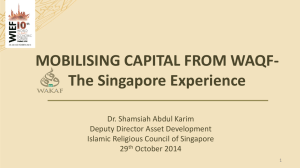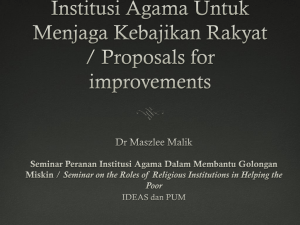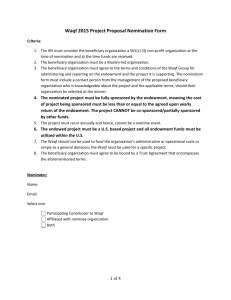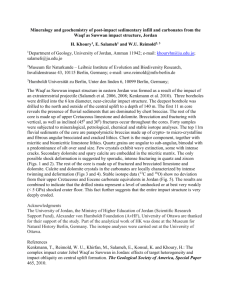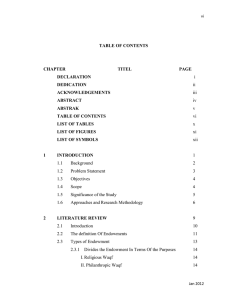Leveraging Philanthropy Monetary Waqf for Micro Finance By
advertisement
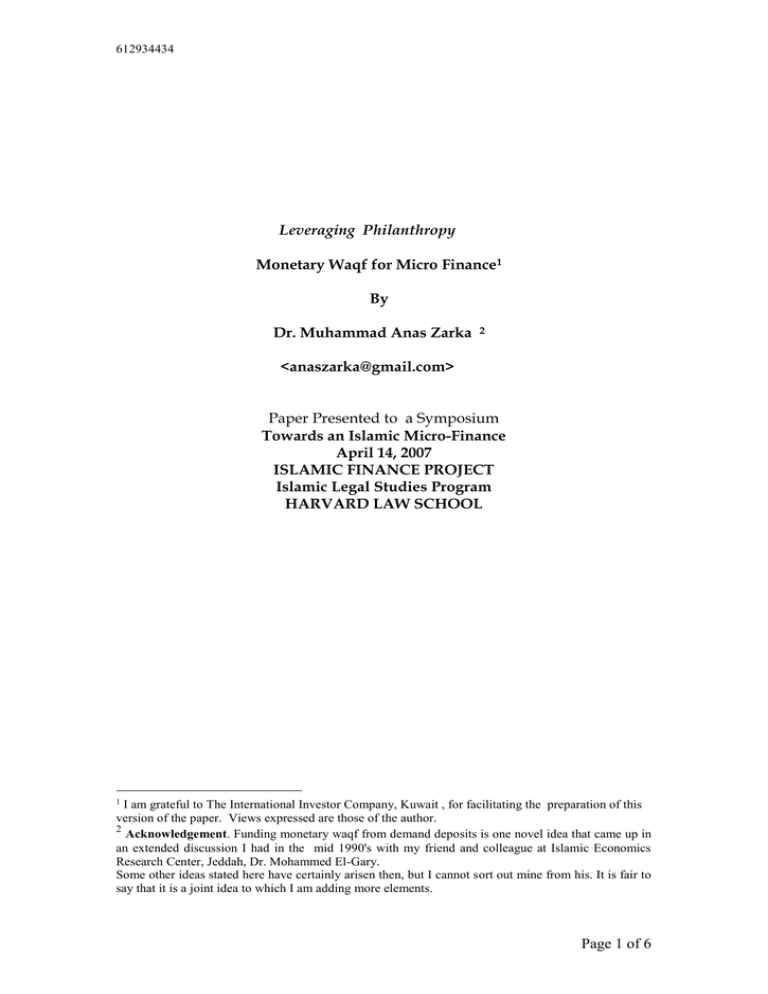
612934434 Leveraging Philanthropy Monetary Waqf for Micro Finance1 By Dr. Muhammad Anas Zarka 2 <anaszarka@gmail.com> Paper Presented to a Symposium Towards an Islamic Micro-Finance April 14, 2007 ISLAMIC FINANCE PROJECT Islamic Legal Studies Program HARVARD LAW SCHOOL 1 I am grateful to The International Investor Company, Kuwait , for facilitating the preparation of this version of the paper. Views expressed are those of the author. 2 Acknowledgement. Funding monetary waqf from demand deposits is one novel idea that came up in an extended discussion I had in the mid 1990's with my friend and colleague at Islamic Economics Research Center, Jeddah, Dr. Mohammed El-Gary. Some other ideas stated here have certainly arisen then, but I cannot sort out mine from his. It is fair to say that it is a joint idea to which I am adding more elements. Page 1 of 6 612934434 ABSTRACT The paper proposes a Monetary Waqf ( MW ) of a variable size, whose major assets are monetary, to provide micro finance to the productive poor. MW depends, as usual in any waqf, on initial permanent donations whose expected income covers the administrative and maintenance needs of MW. A novel feature in the proposed waqf is the mobilization of temporary funds extended to MW as interest-free loans, on call or for a fixed term. MW guarantees repayment to providers of funds, and uses the funds to provide microfinance to the productive poor in various Shariah Compliant modes, at terms that sustain the waqf but are most favorable to recipients. To strengthen its guarantee, MW must have two tiers of philanthropic guarantors: Guarantors of liquidity, and Guarantors of Losses . Guarantors of Losses help insulate fund providers from risk of default by microfinance recipients. This helps to attract to MW temporary funds many times larger than the guarantee commitments. Payments to make up the losses can be counted by these Guarantors towards their annual zakat obligations. Monetary Waqf in the context of Islam’s economic goals Islamic Shari'ah emphasis on distributive justice, surprisingly evident from earliest Makkan Surahs, is a culmination of earlier Divine revelations, only more comprehensive, realistic and clear. Distribution ranks quite high in Shari'ah hierarchy of values, and is an explicit Qur'anic criterion for evaluating a society.[ as evident in Quran 69:34, 89:18]. Refusal to share with the needy is considered transgression "طغيان." 3 Combating poverty, or need fulfillment is the primary goal of re-distribution in Islam and is one expression of the Divine verdict to honor the children of Adam 4. Shariah made it mandatory on the person to earn a living for himself and his dependents. If unable, Shariah installed four major safety nets to relieve poverty of those who cannot fully support themselves: (a) intrafamily maintenance, (b) Zakat , (c) public treasury ( baitul-maal) and (d) ad hoc taxation, in that order. A lower level safety net such as (c) is activated only when a higher-level one such as (a) or (b) is insufficient or inapplicable. If a person’s poverty can be relieved by providing micro-finance, this 3 4 (Al Qalam, 68:16-31]. Al-Israa 17:70 : "We have dignified Adam's offspring.." Page 2 of 6 612934434 becomes a high priority method , because we are helping him/her to do what is mandatory on him, and not be a burden on others. Thus Monetary Waqf as a way to combat poverty fulfils a major economic goal in Islam. Why Islamic finance industry did not do much about social justice? The practical reason initially was the infant industry argument. Viability was much in doubt, and the first order of business was to survive commercially while maintaining Shariah compatibility. Later on, focus of the industry’s captains and clients (?) shifted to achieving good returns. Unremarkably, the industry gave clients what they want, and didn't bind itself to the lofty goals advocated earlier by pioneers of Islamic finance. But there are indeed more durable Fiqh reasons : the modus operandi of the relationship between the industry and its depositors has been the mudarabah contract. This contract, jurists are unanimous, explicitly and for good reason prevents the mudaarib from engaging in non-profit-seeking activities. Woe to the mudaarib who goes further astray and employs the funds received in charitable purposes ! Conclusion: if we want the Islamic financial industry to work for social justice (part time of course, because it must first provide all the important usual services expected of such industry) we must appeal to its clients. They only have the power to mandate philanthropic activities. The present paper is a modest appeal in this direction. The Goal of Monetary Waqf and its Fiqh Structure 5 The Goal is to provide micro-finance to the productive poor in various Shariah Compliant modes, in a sustainable modern institutional setting. The terms of financing must sustain the waqf but should otherwise be most favorable to recipients. “Qard hasan” ( = interest -free loans) cannot be the only mode, because survival of the Monetary Waqf requires generation of some income. The proposed Monetary waqf is an exception from fiqh point of view in two aspects: (a) it is monetary rather than real , and (b) it even employs temporary funds. (a) Though Monetary waqf was discussed and permitted by some early jurists, it was usually deemed an exception with limited applicability. And this for well known sensible reasons; most notably, the high risk of misappropriation and squandering of sums of money. The emergence of modern banks and financial institutions and their Islamic counterparts, and auditing and accounting professions and institutions, has made control and monitoring of sources and uses of sums For fiqh details on monetary and temporary waqf , see Al- Mawsu’a al- fiqhiyyah, Kuwait , Vol. 44, pp. 123-24, 166-67. 5 Page 3 of 6 612934434 of money over extended periods of time quite feasible. Hence Monetary Waqf has become feasible and more desirable; as attested by the widespread appreciation of the great potential of microfinance in poverty alleviation. (b) permanence is a prime requirement of Waqf to most jurists. But temporary waqf has been explicitly approved by some . (c) Note that micro-finance cannot be funded directly from zakah collections, as zakah must be given to the poor and not loaned to them. There is however an important exception that is put to good use by the Monetary Waqf ( see below). The Basic concept Most humans have great reserve of goodwill towards the poor and needy, and like to help them to some extent. Islam and all known religions nurture this moral sentiment and strengthen it. Financing is one form of help that many would love to do, but for two hurdles: cost of administering and collecting the funds, and the risk of loss (default by recipients for any reason). The proposed Monetary Waqf employs “ philanthropic resources” to overcome these two hurdles, thus facilitating for many people of average means to participate in helping the poor through micro-finance. Monetary Waqf assures lenders to the Waqf of instant liquidity for their withdrawals, and insulates them from any risk of default. Beneficiaries Of The Proposed Waqf Eligible recipients of micro-finance are the needy who can be expected to pay back from future income what they receive now. We may call them the productive poor. Would collateral be among conditions for eligibility to receive finance from the Waqf? Answer: Definitely not, and for good reason. Such condition would exclude the weakest and very needy, which have little or no collateral to offer. They are the very people who are denied finance under the current practice. We must substitute by using group social and moral collateral, and benefit from earlier experiences in this regard by Grameen Bank and others. Can the productive poor receive zakah? Yes , for sure. But helping them by micro-finance, if possible, is more sensible from both Shariah and economic points of view. It spares more zakah funds to the unproductive poor , such as the sick or very old. Providers Of Funds To The Proposed Waqf. There are four groups of providers: Page 4 of 6 612934434 Donors Permanent donations of money and real resources may be accepted by The Waqf, no matter how small. This opens the door for wide public participation. Lenders of qard hasan: An innovative feature of this waqf is that also it employs in micro financing some of the temporary financial resources that it had received as qard hasan from Lenders. This opens a large untapped source for microfinance from demand deposits. Suppose for simplicity that Monetary Waqf keeps an account at each major bank to facilitate the following scenario: A Bank client willing to become lender to the Waqf may issue his bank a standing order like this: "whenever my current account ( saving account) exceeds a certain level, I hereby authorize you, the Bank, to loan the excess on my behalf to the Monetary Waqf account with you. If my account falls short of that level, please replenish it from what the Monetary Waqf owes me". Lenders to the Waqf may do so either for a fixed term (say a month to a year) or may provide funds they can recall on demand. Just as banks had discovered that not all demand deposits are withdrawn at the same time, and that some new deposits come as others go, the Monetary Waqf can prudently extend micro-finance from total accumulated loans it received. Loan withdrawals may give rise to occasional liquidity shortages. To guard against this the Monetary Waqf ,like good bankers, would keep some idle fund as reserves. Waqf should also have Guarantors of Liquidity. Guarantors of Liquidity: Each guarantor promises to lend the Waqf a certain sum of money as qard hasan if and when the waqf needs liquidity to honor withdrawals by Lenders. Such loans will be for a given term, say 3 months, and will not be used to provide micro finance directly. Guarantors of Losses: Some of the micro financing extended will not be paid back for whatever reason. Monetary Waqf may or may not be able to cover such losses from the income generated from successful financing deals. The waqf should have Guarantors of Losses who stand ready to donate specific sums of money to cover such losses. Note that in many cases, a beneficiary who becomes unable to pay back the micro finance he had received also becomes ghaarim (one burdened with debt) according to zakat rules in the Holy Quran ( 9:60). He thus Page 5 of 6 612934434 becomes a legitimate recipient of zakat to pay back what he owes the Waqf. Hence, Guarantors of Losses can pay the sums they pledge from their zakat. 6 This gives strong incentive to many persons to become guarantors and is likely to have a commendable multiplier effect on potential lenders to the Waqf. For, suppose the rate of losses on micro finance extended is say 5%. A guarantor of 5 dinars to cover losses will protect 100 dinars loaned to the Waqf, inducing many people to become riskless lenders. Thus we see strong complimentarily between zakat, which must be given as one-way- transfer to the poor and cannot be advanced to them as a loan, and Monetary Waqf which is designed to provide charitable finance. Prospects Availability of resources to fund Monetary Waqf is a lesser and transitional hurdle in my view. Once a small Monetary Waqf establishes its integrity, effectiveness and financial soundness in any community, many people will come forward as Providers of funds. There are however two enduring constrains: First: Availability of quality managerial talent to impartially screen potential beneficiaries, dispense financing efficiently and recoup funds (i.e. achieve very low rate of defaults). Second: Innovative business and engineering talent to assess soundness of projects the poor may propose, and to generate for those lacking a proposal a large number of promising micro projects (both productive and skill building) that are well tailored to the abilities and local economic environment of the poor. Analytic Postscript Philanthropy is a very scare resource. A well known economist (can’t recall the name !) suggested we should use it sparingly in any proposed policy or institution. Institutional economics teaches us the importance of transaction costs ( in our case: costs and risk to lenders to Monetary Waqf) . The present paper takes these two pieces of wisdom to heart by structuring a Monetary Waqf that leverages as far as possible its three “ philanthropic resources”, namely : waqf donations, the moral sentiments of Guarantors of Liquidity and the share of garimeen ( those burdened with debt) in zakah provided by Guarantors of losses. It employs all three to eliminate the transaction costs to lenders to the waqf, thus increasing the flow of funds to micro-finance. 6 I am grateful to Sheikh Dr. Ahmad Al-Hajji Al-Kurdi, member of Fatwa Committee of Ministry of Awqaf, Kuwait, for this important idea. Page 6 of 6
